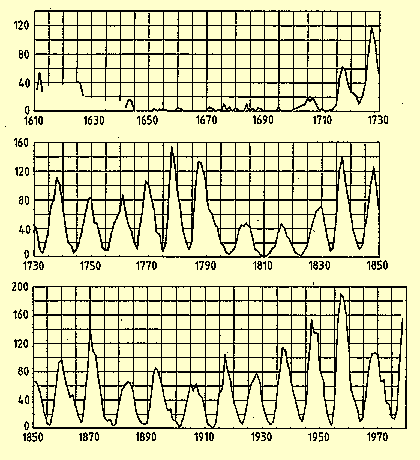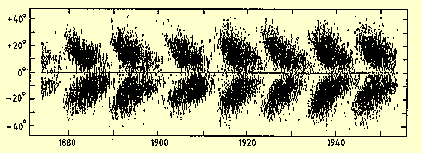Chapter I
Solar magnetic activity
2. The solar cycle
The Sun has always been an object of great interest to mankind
since it is vital to our life:
it provides light and warmth.
One feature occasionally observed,
mentioned already in records dating back to a couple of centuries B.C.,
are "dark spots" on the solar surface.
Only since the invention of the telescope in 1610
these sunspots can be studied in some detail
because most sunspots are invisible for the naked eye.
Especially since about 1700
a great number of observations has been collected; see Fig. 1.
An overview of historic records of sunspots and related characteristics
is given by Eddy (1976, 1977a,b) and Clark and Stephenson (1978).
Such studies show
that there have been several decades with almost no sunspots.
The most recent of these periods of reduced solar activity
is the so-called Maunder Minimum,
from about 1645 to 1710 (see Fig. 1).
This minimum in sunspots is real
and not due to insufficient observations;
Weiss and Weiss (1979) discussed a 17th century poem
which shows that the lack of sunspots was well known at that time.
 Figure 1
Figure 1
The number of sunspots as a function of time
since the invention of the telescope.
The period of almost no sunspots in the 17th century
is named the Maunder Minimum.
Each cycle has received a number;
cycle 20, for instance, starts in 1964 and ends in 1976.
[After Zirin (1988).]
In 1843 Schwabe discovered that the number of sunspots
exhibits a cyclic behaviour with a period of about 11 yr:
the sunspot cycle.
Sunspots live a few days or weeks and then disappear again.
Early in a cycle the sunspots appear at mid-latitude,
and then at progressively lower latitudes (Spörer's law, 1894).
The result of this migration process is
the familiar butterfly diagram
which shows the latitudes of sunspots on the surface as a function of time;
it was first drawn by Maunder in 1922.
Figure 2 presents an example of such a diagram.
 Figure 2
Figure 2
The observed migration of sunspots from mid-latitudes to the equator.
Each "butterfly" represents one 11-yr sunspot cycle.
[After Kiepenheuer (1959).]
Hale proved in 1908 that sunspots are associated
with strong magnetic fields.
Modern magnetograms of the Sun
show that sunspots are components of magnetic bipolar regions.
Hale observed that on one hemisphere the leading parts
of these active regions
(with respect to the direction of the solar rotation)
all have the same polarity,
while on the other hemisphere the polarities are oppositely oriented.
In subsequent 11-yr sunspot cycles
the polarities in the active regions are reversed.
This are Hale's polarity laws (Hale, 1924);
there are only few exceptions to these rules.
The Sun therefore exhibits in fact a 22-year magnetic cycle.
The nature of the "dark spots" on the solar surface has long been a mystery.
Early observers thought they were planets in front of the Sun,
others that they are the slag of the burning Sun or clouds of smoke.
Nowadays it is known that sunspots are darker than the surrounding surface
because they are cooler:
the normal solar surface (photosphere) has a temperature of about 5800 K,
whereas sunspots are about 4000 K.
The lower temperature is presumably caused
by the magnetic fields in sunspots
suppressing the convective heat transfer.
Sunspot magnetic fields have a strength of a few thousand
gauss*),
whereas the average photospheric field strength is much less:
less than a few gauss (G).
For comparison: the strength of the Earth's
magnetic field is about 0.6 G at the poles.
The time in which an existing magnetic field in the Sun
decays due to resistivity alone is of the order of 10 milliard years,
which is comparable to the Sun's lifetime.
The origin of the solar cycle is therefore sought
in some kind of dynamo process in (the convection zone of) the Sun
which continuously regenerates the magnetic field
and thus sustains the cyclic behaviour.
This dynamo process, described qualitatively in Sect. 3,
must then explain the observed magnetic features.
Surface effects of emerging magnetic flux are
not discussed here in detail; for a description see,
for instance, Babcock and Babcock (1955),
Howard (1974), Spruit et al. (1987) and Zwaan (1985, 1992).
Observations indicate that active regions are
the surface manifestation of a toroidal magnetic field
(i.e. a field parallel to the equator)
which erupts from the interior of the Sun
in the form of loops (cf. Fig. 6).
These bipolar active regions live a few days to weeks,
sometimes a few months, and then disintegrate
in progressively smaller magnetic regions and thus gradually dissolve.
What actually happens during this decay process is unknown,
but it seems that the field disappears underneath the surface.
In the course of the 11-yr cycle this process of
development and decay of active regions
takes place at progressively lower latitudes,
which shows up as the apparent migration of sunspots
towards the equator in the butterfly diagram (Fig. 2).
It thus seems that it is the toroidal field
which moves towards the equator
and which reverses direction every 11 yr.
During the decay of active regions
the leading parts are mainly spread
(by surface diffusion) towards the equator
and the trailing parts mainly towards the poles.
Most of these regions gradually disappear.
A number of following parts, however, does not disappear
but forms so-called unipolar magnetic regions which migrate poleward.
These unipolar regions have a polarity which is opposite
to the polarity of the existing polar field (cf. Fig. 6).
This causes a reversal of the polar field,
which takes place some years after the reversal of the toroidal field
and not at both poles simultaneously (see also Yoshimura, 1976;
Wang et al., 1989b; Wilson et al., 1990;
Wang and Sheeley, 1991).
The mean polar field of the Sun is relatively week (only a few gauss)
and it is not organized in active regions;
see e.g. Babcock (1961), Stenflo (1970, 1971), Howard (1974),
and Howard and LaBonte (1981).
Only about 1% of the total magnetic flux is at the poles,
whereas about 70% is concentrated in the area between ca. 30 degrees latitude.
Information on the polar field is rather difficult to obtain
since we are looking almost along the surface of the Sun there.
The Ulysses probe which flies above the solar
south pole in 1994 and north pole in 1995
will provide us with a "look from above".
*) To keep in pace with the rest of the astronomers' world
the c.g.s. system of units is used in this thesis.
In the International System of MSKA units
the magnetic field strength is measured in tesla (T);
1 gauss (G) in the c.g.s. system equals 0.0001 T.
Forward to 2.1 The sunspot cycle
Back to the contents
Back to the thesis page
 Jos van Geffen --
Home |
Site Map |
Contact Me
Jos van Geffen --
Home |
Site Map |
Contact Me
last modified: 26 May 2001
 Figure 1
Figure 1 Figure 2
Figure 2 Jos van Geffen
Jos van Geffen